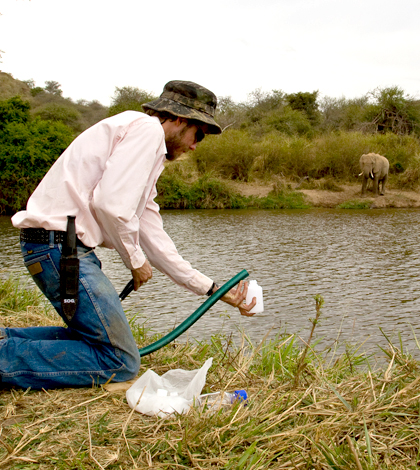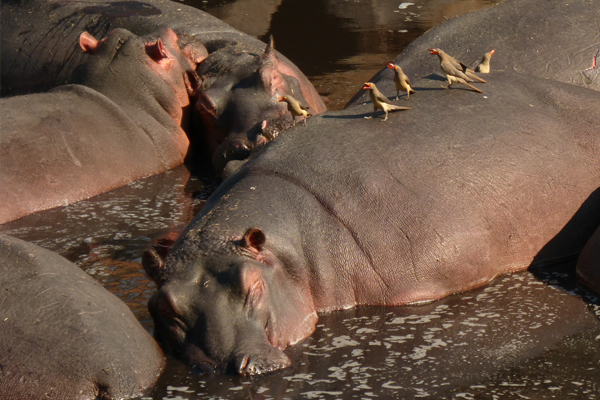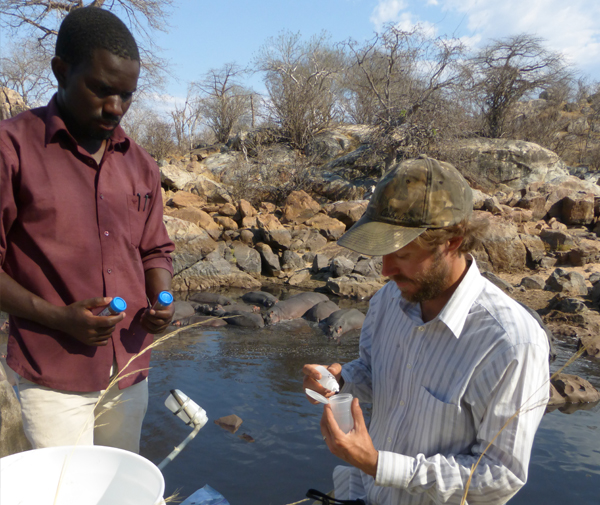Hippo Dung Revealed As Important Food Source In African Rivers

The presence of hippopotamus and crocodiles in East African rivers increases the complexity of collecting water samples.. (Credit: UC Santa Barbara)
Few studies have looked at the effects hippos have on the water quality of streams. And the reason is simple: Studying near hippos isn’t safe.
“It’s an ornery animal to work with,” said Doug McCauley, assistant professor of ecology, evolution and marine biology at the University of California, Santa Barbara, who just completed a study measuring the effects of hippo dung on the ecosystem of an African river. “When you’re sampling in a stream with salmon, there’s no threat that a salmon would bite you in half.”
But for studies near gigantic hippos, the threat of danger is very real. So McCauley and other scientists from UC Berkeley and Princeton University were extra cautious during their time sampling in the Ewaso Ng’iro River, doing things like adjusting their sampling times to avoid hippo herds or traveling with escorts from the Kenya Wildlife Service.
Researchers’ efforts charted the impacts of hippo dung by looking at its usefulness to fish and insects in the waterway. Their results are some of the few that tell of hippos’ effects on ecosystems and underscore the need to protect hippo populations in decline.

Hippopotamus introduce tons of organic matter annually into aquatic ecosystems that can act as a natural fertilizer for river and lake food webs. (Credit: UC Santa Barbara)
Researchers began by feeding ground hippo dung to Trinidad guppies in lab tanks. This allowed them to see if the dung could serve as a food source for fish. As many aquarium enthusiasts know, guppies will eat most anything and they took no exception to the hippo waste.
“We used that information to interpret what it looked like in the wild,” said McCauley. “As it turns out, hippo dung is wonderful guppy food.”
The next step from there was collecting data in the field. Much of this relied on water samples from the Ewaso Ng’iro River that scientists analyzed for hippo nutrients. Combined with this were tissue studies of barbel fish, the most common in the river, as well as those from dragonfly larvae.
Chemical analysis showed that the tissues of those fish and insects were made up mostly of hippo dung. McCauley says that the findings make sense, but he was still intrigued to see the evidence encoded in the chemistry of fish and insect blood.
“What we see is this really important food that fish eat and take up biomass from,” said McCauley. “Hippo dung may be an important food source for fueling productive fisheries. There is solid evidence that fish use resources derived from hippos.”

Douglas McCauley and James Mpemba test pH and dissolved oxygen concentrations of water samples collected from a river pool with a large pod of hippopotamus in Ruaha National Park, Tanzania. (Credit: UC Santa Barbara)
Another neat find, which is part of a related research project, was the effects that water flow has on the usefulness of hippo resources. They become more or less available to creatures in the river ecosystem based almost solely on flow.
The Ewaso Ng’iro River runs perennially, McCauley says, but dries out as it moves toward Somalia. So the hippo matter can be extra food in some places, but too highly concentrated in others. Human actions, he says, are largely to blame for the river’s diminished flows.
“When rivers dry up, there can be isolated pools that have too much nutrient input, the result of not enough water and too many hippos,” said McCauley.
In addition to the finds on water flow and how creatures use hippo waste, McCauley says the research brings attention to a larger issue not getting a lot of scrutiny these days: declining hippo populations. Like lots of large-animal populations, hippos have been losing habitat range in recent decades. And conservationists have noted 10 to 20 percent declines in hippo numbers.
Those declines are forecast to continue, which is a huge loss to nature’s biodiversity portfolio, he says.
“Beyond the obvious loss of a wonderful animal, we’re losing an important biological force,” said McCauley. “They fuel life in these rivers that would be lost without hippos. It raises the stakes on their declines.”
Top image: The presence of hippopotamus and crocodiles in East African rivers increases the complexity of collecting water samples. (Credit: UC Santa Barbara)




Pingback: WTF? I thought this was an entomology blog? | confessions of an entomologist